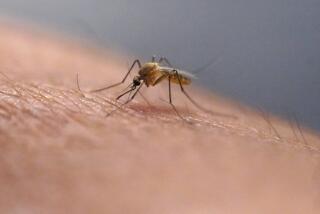Dengue, where is thy sting?
- Share via
JUAZEIRO, Brazil — Under normal circumstances, Cicera Maria da Silva would be less than excited about a researcher intentionally releasing thousands of mosquitoes just outside her husband’s corner grocery store.
Mosquitoes here are not just a ubiquitous annoyance; they spread deadly diseases, including dengue fever, which struck Da Silva’s mother a year ago.
But that’s why she’s OK with the truck that passes through this poor corner of Brazil a few times a week and pours so many of the winged creatures into the hot streets. These genetically engineered members of the species Aedes aegypti have been created in a lab, and are aimed at wiping out their brethren.
“What my mom went through when she got dengue was really, really bad,” Da Silva says. “Anything that can be done to fight that is worth trying.”
The small, sun-scorched neighborhood of Itaberaba in this city in Bahia state is the leading testing ground for a controversial effort to combat dengue fever, the harrowing disease that kills 22,000 people a year worldwide. Scientists backed by the state government are releasing millions of the engineered mosquitoes into the wild with the goal of exterminating the species here — and, perhaps eventually, the entire country or world.
Dengue fever can range in severity from a flu-like condition to hemorrhagic fever to death, and while the goal of eliminating mosquitoes en masse isn’t new — usually through insecticides, which also affect other species — the genetic engineering approach is.
Lab workers use a needle to inject altered DNA into female mosquitoes’ eggs. When the modified Aedes aegypti males breed in the wild, the larvae produced by females die young, before they can go on to bite anyone.
In Itaberaba, 84% of mosquito larvae now carry the modified gene, which means they will die before maturing, according to workers at the Moscamed lab in Juazeiro, which uses a process developed at UC Irvine and the Oxitec company in London. Pleased with the results, the state government has approved expansion of the program to five neighborhoods.
Scientists in Brazil are waiting for permission to take the next step: the carpet bombing of an entire city, Jacobina, with the male zombie mosquitoes.
Modified mosquitoes have also been released into uninhabited areas of India and Malaysia. But not everyone is enamored with the technology. In the Florida Keys, local authorities are awaiting the results of a Food and Drug Administration analysis before moving forward with research, and some residents have expressed concern over a practice that sounds like something out of a science-fiction movie.
GeneWatch, a British-based nongovernmental group, opposes the Brazil program, saying the unintended consequences could include the possibility that some next-generation mutants survive and that a temporary reduction in dengue fever could be counterproductive by lowering human immunity.
“There are a number of ways in which nature can respond to releases and actually make the dengue situation worse,” says Helen Wallace, director of the organization.
Researchers here counter that their experiments are fundamental to finding out whether any of the mosquitoes survive. So far, they say, none have, and even if they did, negative consequences are unlikely because the altered gene is nontoxic and not spread by saliva.
“There are always unknown unknowns, so to speak, but we think these are outweighed by the known setbacks of the other approaches,” says Anthony James, a professor at UC Irvine, where the technology for inserting the altered DNA into eggs was perfected. “Most of the concerns are about some unintended off-target effects [involving species beyond the Aedes], but we know exactly what the off-target effects of insecticide are.”
“Yes, there is a radical ecologist wing that thinks you shouldn’t get involved with nature no matter what, and there are those of us who think fighting disease is worth it,” says Danilo Carvalho, technical director of the Transgenic Aedes Project, the government-funded effort being carried out at Moscamed.
That argument holds sway with many in the poor neighborhoods of Juazeiro, where standing water allows mosquitoes to flourish in a hot, dry climate.
“It’s good, it’s important, and it doesn’t bother me,” says Marinalva de Santos Feitosa, who acknowledges she doesn’t really understand the science as she allows biologists into her backyard to check on the progress of the local population. Male Aedes don’t bite, so being swarmed with them isn’t painful, although it’s impossible to talk during the liberation sessions without accidentally swallowing a few of the Frankenbugs. For the release to be effective, scientists must unleash far more of their own mosquitoes than there are wild ones in the area.
Back at the lab, Carvalho surveys rows and rows of mosquitoes coming of age in big white buckets, nourished by goat’s blood. The males will be separated from the females — easy, as they aren’t even close in size — before hitting the streets.
Prior to the pilot program in Itaberaba, researchers launched an extensive effort to educate residents about what they were doing and why residents should welcome the white truck that rolls slowly through the neighborhood, labeled with the word “Transgenico” and an image of a mosquito emerging from a DNA double helix. The campaign included a catchy jingle, to the tune of lighthearted Brazilian music:
Let him into your house
He’s the solution
He fights dengue
and won’t bite anyone
Protect your health
He’s the good mosquito
Bevins is a special correspondent.
More to Read
Sign up for Essential California
The most important California stories and recommendations in your inbox every morning.
You may occasionally receive promotional content from the Los Angeles Times.










